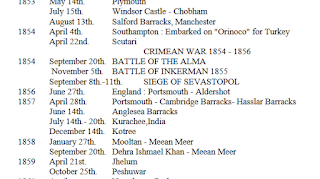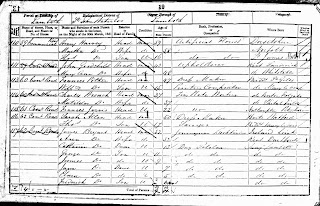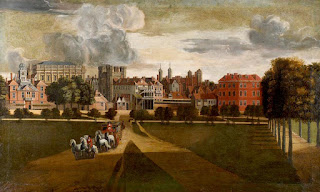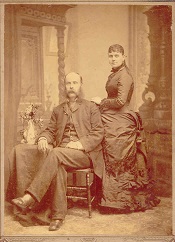Allens serve in Royal Scots Fusileers in 1855
Two of the Allen brothers served with the Royal Scots Fusilleers 2 Battalion as drummers as we know from the letter we think the letter is from 1856 and brother John A Allan is back in England after serving in the Crimean War . Another brother George H is also serving in the same unit as John. John also mentions service in St Helena in the letter ---
In 1854, the Crimean War began, which pitted the United Kingdom, France and the Ottoman Empire
 against the Russian Empire. The 1st Battalion of the Scots Guards Fusiliers were dispatched as part of the Guards Brigade to the East, being deployed to Malta, Bulgaria and Turkey, before, in September, the British finally landed in the Crimea, at a place called Calamity Bay. The British and their French allies then began the advance on Sevastopol, a Russian naval base, but was blocked at the River Alma by Russian forces. And here came the Battalion's first engagement at the Battle of Alma, an action that saw chaotic and heavy hand-to-hand combat between the British and Russians. The road to Sevastopol runs through a gap between two hills, one to the east, known as Kourgane Hill and the other to the west, known as Telegraph Hill. On Kourgane Hill there consisted two earthworks, one known as the 'Great Redoubt' on the western side of the hill, while the other was on the eastern side, known as the 'Lesser Redoubt'.
A British unit, known as the Light Division, made their advance, making steady progress on the Great Redoubt, and took it with very heavy casualties, however chaos soon set in, after, during a Russian counter-attack, a confusing order from an unknown officer was soon contradicted by other officers, and the British duly fell back. The Scots Fusilier Guards, in the center of the Guards Brigade, part of the 1st Division, were supporting the Light Division, though had only just crossed the River Alma by the time the Great Redoubt was taken. One brave group of Royal Welch Fusiliers had held their ground and were firing into the Russians until confronted by a mass of Russian soldiers, forcing them to retreat rapidly, and in the process, smashed straight into the formation of the advancing Scots Fusiliers Guards, causing immense chaos. The Russians seized their opportunity to strike, launching a large-scale bayonet charge on the regiment, resulting in brutal
against the Russian Empire. The 1st Battalion of the Scots Guards Fusiliers were dispatched as part of the Guards Brigade to the East, being deployed to Malta, Bulgaria and Turkey, before, in September, the British finally landed in the Crimea, at a place called Calamity Bay. The British and their French allies then began the advance on Sevastopol, a Russian naval base, but was blocked at the River Alma by Russian forces. And here came the Battalion's first engagement at the Battle of Alma, an action that saw chaotic and heavy hand-to-hand combat between the British and Russians. The road to Sevastopol runs through a gap between two hills, one to the east, known as Kourgane Hill and the other to the west, known as Telegraph Hill. On Kourgane Hill there consisted two earthworks, one known as the 'Great Redoubt' on the western side of the hill, while the other was on the eastern side, known as the 'Lesser Redoubt'.
A British unit, known as the Light Division, made their advance, making steady progress on the Great Redoubt, and took it with very heavy casualties, however chaos soon set in, after, during a Russian counter-attack, a confusing order from an unknown officer was soon contradicted by other officers, and the British duly fell back. The Scots Fusilier Guards, in the center of the Guards Brigade, part of the 1st Division, were supporting the Light Division, though had only just crossed the River Alma by the time the Great Redoubt was taken. One brave group of Royal Welch Fusiliers had held their ground and were firing into the Russians until confronted by a mass of Russian soldiers, forcing them to retreat rapidly, and in the process, smashed straight into the formation of the advancing Scots Fusiliers Guards, causing immense chaos. The Russians seized their opportunity to strike, launching a large-scale bayonet charge on the regiment, resulting in brutal  suffered 6,000. For their actions at Alma, the Scots Fusilier Guards won a battle honour and four men of the regiment would later win the Victoria Cross, an award created in 1856 to become the highest award for valour in the face of the enemy. These men were Captain Robert James Lindsay, Sergeants John Knox and James McKechnie, as well as Private William Reynolds.
In 1855, the regiment took part in another bloody engagement, at the Battle of Inkerman, at a place known to the British as Mount Inkerman. The British, and their French allies, were attacked by numerically superior Russian troops, hoping to break the Siege of Sevastopol. The attack happened in very thick mist and despite having weak defences and being outnumbered severely, the British defended stoutly against the Russians. The first Russian attacks was completely devastated by the accurate fire of the badly outnumbered British defenders. The Guards helped defend the right of the British defenders, and at Sandbag Battery, performed valiantly in the face of overwhelming Russian numbers, and despite the difficulties the Guards faced, they overcame them and devastated the Russian forces assaulting the Sandbag Battery. The Battle of Inkerman was a victory that had been filled with dreadfully brutal hand-to-hand combat, that, at times, resembled the battles of a far more primitive age, and saw over 2,000 British soldiers killed or wounded out of over 8,000 that took part in the battle, with the Russians suffering over 11,000 casualties. The regiment
suffered 6,000. For their actions at Alma, the Scots Fusilier Guards won a battle honour and four men of the regiment would later win the Victoria Cross, an award created in 1856 to become the highest award for valour in the face of the enemy. These men were Captain Robert James Lindsay, Sergeants John Knox and James McKechnie, as well as Private William Reynolds.
In 1855, the regiment took part in another bloody engagement, at the Battle of Inkerman, at a place known to the British as Mount Inkerman. The British, and their French allies, were attacked by numerically superior Russian troops, hoping to break the Siege of Sevastopol. The attack happened in very thick mist and despite having weak defences and being outnumbered severely, the British defended stoutly against the Russians. The first Russian attacks was completely devastated by the accurate fire of the badly outnumbered British defenders. The Guards helped defend the right of the British defenders, and at Sandbag Battery, performed valiantly in the face of overwhelming Russian numbers, and despite the difficulties the Guards faced, they overcame them and devastated the Russian forces assaulting the Sandbag Battery. The Battle of Inkerman was a victory that had been filled with dreadfully brutal hand-to-hand combat, that, at times, resembled the battles of a far more primitive age, and saw over 2,000 British soldiers killed or wounded out of over 8,000 that took part in the battle, with the Russians suffering over 11,000 casualties. The regiment  won its thirteenth battle honour for their part at Inkerman.
The Scots Fusilier Guards also took part in the arduous Siege of Sevastopol, which lasted from September 1854 to September the following year, when it was captured by the British. The Crimean War would end in 1856 with the Treaty of Paris, with the Scots Fusilier Guards returning home to the UK that same year
won its thirteenth battle honour for their part at Inkerman.
The Scots Fusilier Guards also took part in the arduous Siege of Sevastopol, which lasted from September 1854 to September the following year, when it was captured by the British. The Crimean War would end in 1856 with the Treaty of Paris, with the Scots Fusilier Guards returning home to the UK that same yearcarnage, eventually forcing the regiment to reluctantly withdraw, and suffering over 150 casualties. During this chaos, the Colour party of the regiment, whose Colours had been shot through, held their ground against the overwhelming Russian force, and safeguarded the Colours from the Russians, as well as helping to rally the regiment. The Russians attempted to exploit the chaos when a large Russian force advanced on the Brigade of Guards, but the Guards poured a withering and accurate fire into the Russians, causing very heavy casualties. The British, including men of the battered Scots Fusilier Guards, subsequently advancing, causing the Russians to flee which allowed the British to re-take the Great Redoubt. Further heroics occurred on the right, with the Highland Brigade, just two lines deep, firing, while advancing, on the Russians who soon fled from the spirited Highland Brigade. The Battle had been bloody, with the British losing over 2,000 casualties while the Russians
This exactly what John would have looked like and maybe knew some of these guys
nglish: Crimean War 1854 - 1856
A group of Scots Fusilier Guards convalescing from wounds received in the Crimea at the Guards Barracks in London. Left to right:
- Private G. Biddlescombe
- Private Francis Trainer
- Private George Watt
- Private William Jay
- Private Edward Little
- Private J.F. Lilley
- Private William McPherson
- Private James Morgans
| Date | between circa 1854 and circa 1856 |















